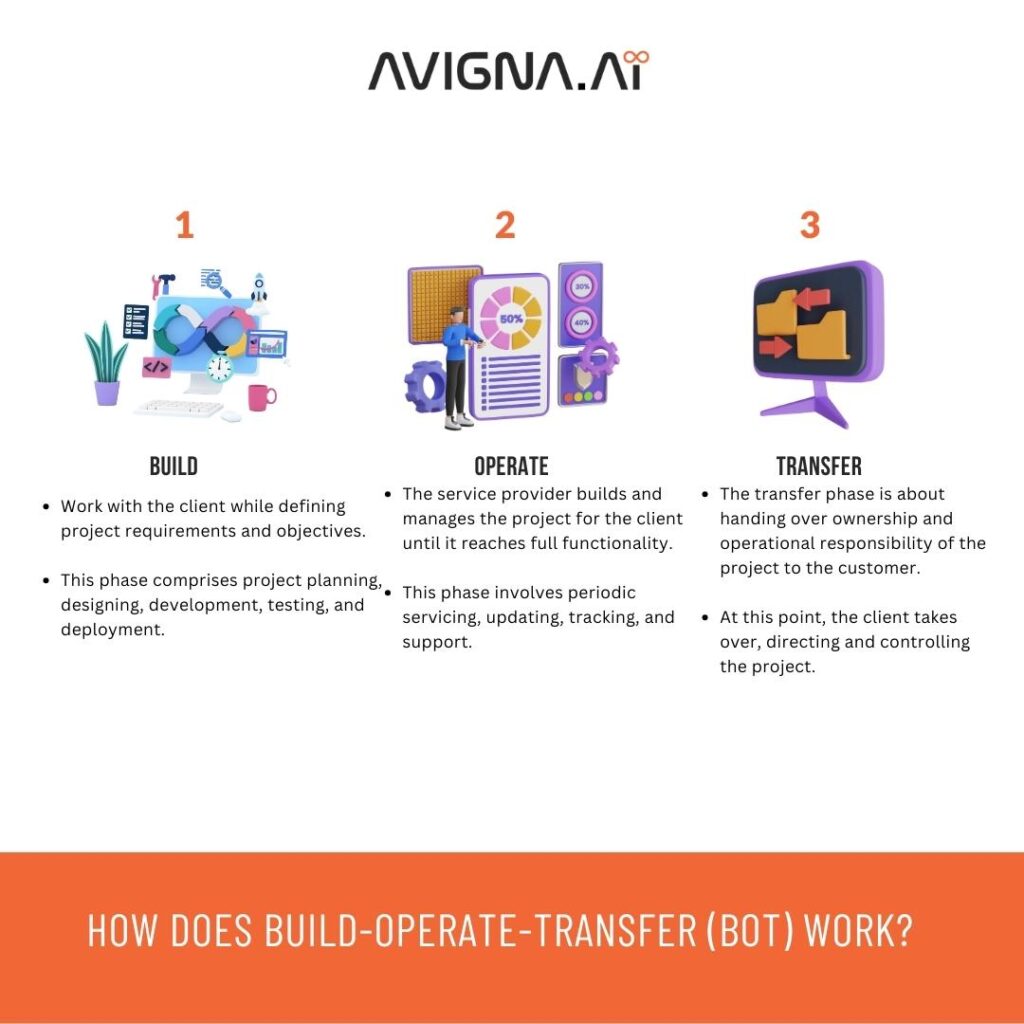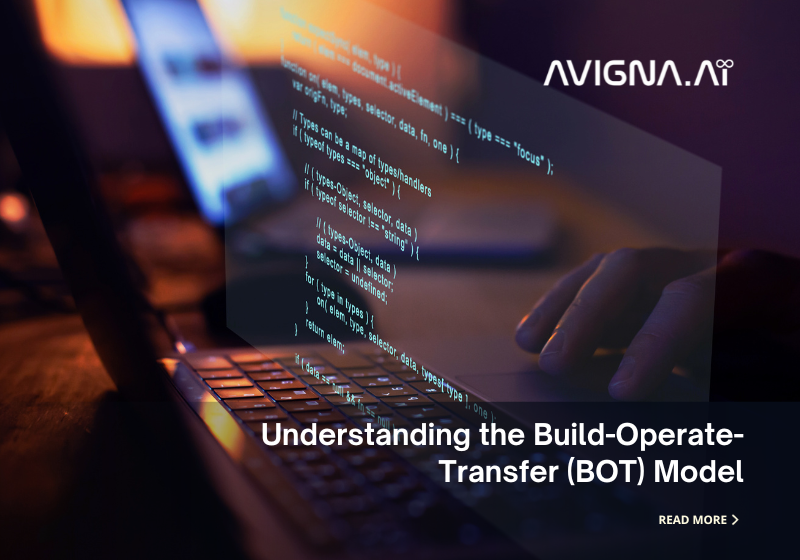Software development is a thriving market that has seen many companies outsource some of their work activities to it. Outsourcing involves several firms ranging from startup companies to large corporations that use an international resource base to lower operation costs.
The BOT model is becoming increasingly popular these days as one of the most preferred methods. This article aims to provide more visions of the BOT model, exploring its significance and how it simplifies the process of outsourcing software projects
Exploring the Technicalities of the Build-Operate-Transfer (BOT) Model
BOT refers to a type of business engagement in which a firm collaborates with another service provider to build, operate, and later on, transfer an assignment or a business process. This is frequently used in software but is useful across several enterprises.
Let’s explore the details of the three distinct phases that comprise the BOT model:
Build
The first phase entails working together with the client company while defining project requirements and objectives. Upon signing the contract, the service provider should develop an app, a product, or provide a service. It comprises activities such as project planning, designing, development, testing, and deployment.
Operate
The service provider constructs and manages the project for the client until it reaches full functionality. It involves periodic servicing, updating, tracking, and support. These are ongoing operational services that are paid by the client as a fee to the service provider. The client benefits from the service provider’s expertise in managing the project efficiently.
Transfer
The final stage in the BOT model is the transfer phase. Transition is about handing over ownership as well as operational responsibility of the project to the customer. At this point, the client takes over, directing and controlling the project. The client can now choose whether to handle the project on its own or involve another service provider.

The Significance of BOT
Now that we have a basic understanding of the BOT model, let’s discover why it’s significant in the context of outsourcing and software development:
Risk Mitigation
One of the key advantages of the BOT model is risk mitigation. The client can share the risks associated with the project with the service provider. The service provider manages and mitigates risks during the build and operational phases. It allows clients to focus on their core competencies without concern about project risks.
Cost Efficiency
In the BOT model, the client pays for the product and operational services the service provider provides. It is often more cost-effective than hiring and maintaining an in-house development team. Additionally, the client can leverage the cost advantages of offshore development centers.
Access to Expertise
Service providers in the BOT model are typically specialized in their domains. Clients can tap into the expertise of these providers to ensure high-quality project development and management. This access to specialized skills and knowledge can lead to faster project delivery and better outcomes.
Scalability
The BOT model allows for scalability and flexibility. As the client’s project grows or changes, they can quickly scale up or down their operational needs with the service provider. This scalability ensures the client can adapt to market dynamics and evolving project requirements.
Analyzing the BOT Model’s Impact on Outsourcing Efficiency
Let’s explore the processes by which the BOT model enhances the efficiency of outsourcing software development projects:
Clear Objectives and Ownership
The BOT model starts with a clear definition of project objectives and ownership. This clarity is essential for both the client and the service provider. It ensures everyone understands their roles and responsibilities throughout the project’s lifecycle.
Efficient Resource Utilization
The client can efficiently utilize resources by outsourcing the build and operate phases. They can focus on their core business activities while the service provider manages project development and operations. This division of labor leads to resource optimization.
Transition Planning
Transition planning is a critical aspect of the BOT model. From the outset, both parties plan to transfer project ownership. It includes defining the criteria for a successful transfer and ensuring that knowledge transfer occurs smoothly.
Risk Sharing
The BOT model shares risks between the client and the service provider. The service provider takes on significant project-related risks during the build and operation phases. This risk-sharing arrangement can be particularly beneficial for clients who want to minimize their exposure to project uncertainties.
Key Considerations for BOT Success
Before commencing a Build-Operate-Transfer (BOT) model project, it’s important to consider several crucial aspects:
Selecting the Right Service Provider
Choosing the right service provider is crucial for the success of a BOT project. Clients should evaluate potential partners based on their expertise, track record, and cultural fit. Due diligence in selecting a service provider can mitigate many risks.
Legal and Contractual Aspects
BOT agreements involve complex legal and contractual aspects. Clients should work closely with legal experts to draft comprehensive contracts covering all model phases. It includes ownership transfer, intellectual property rights, and dispute resolution mechanisms.
Cultural Alignment
Cultural alignment between the client and the service provider is often overlooked but essential. A shared understanding of values, communication styles, and work ethics can facilitate a smoother collaboration.
Exit Strategy
Clients should also have a clear exit strategy if the partnership with the service provider doesn’t go as planned. It includes provisions for terminating the agreement and transitioning to a new provider if necessary.
Benefits of BOT
- Risk Mitigation: The BOT model allows clients to share project risks with the service provider, reducing the client’s exposure to uncertainties.
- Cost Efficiency: Clients can save significantly by outsourcing project development and operations.
- Access to Expertise: Clients benefit from the specialized skills and knowledge of the service provider, leading to high-quality project outcomes.
- Scalability: The BOT model offers flexibility, enabling clients to scale their projects as needed.
Challenges of BOT
- Complex Legal Framework: BOT agreements involve intricate legal and contractual aspects that require careful consideration.
- Cultural Differences: Misaligning values and work cultures between clients and service providers can lead to collaboration challenges.
- Transition Risks: Ensuring a smooth transition of project ownership can be a complex process with potential pitfalls.
Build Operate Transfer Real-World Examples
To demonstrate the BOT model’s practical implementation, let’s examine a few real-world case studies:
Example 1: IT Outsourcing
As an example, a US-based technology firm engages an Indian service provider to develop and maintain its software products. A BOT agreement is signed between them. The Indian service provider constructs the software, operates it, and then sells it to the American firm. The US company can leverage cost-effective offshore development while maintaining product control.
Example 2: Infrastructure Development
A government agency in a developing country wants to build a new transportation infrastructure project, such as a highway. They partner with an international construction company under a BOT model. The construction company designs, builds, operates, and maintains the route for a specified period, collecting tolls.
After the agreed period, ownership and operation of the highway are transferred to the government agency. It enables the government to access the expertise of the construction company and fund the project without incurring immediate costs.
The Way Ahead
By clearly defining project objectives and ownership, efficiently utilizing resources, and planning for a smooth transition, clients can successfully leverage the BOT model for their outsourcing needs. Selecting the right service provider is essential, addressing legal and contractual aspects, ensuring cultural alignment, and having an exit strategy in place.
With careful consideration of these factors, organizations can harness the full potential of the BOT model to achieve their software development goals. The BOT model is a valuable tool in the outsourcing toolbox, and when used strategically, it can lead to successful software development projects and business growth.
As the global outsourcing market continues to evolve, the BOT model remains a relevant and practical approach for organizations seeking to optimize their operations and achieve their strategic objectives.

Conclusion
The Build-Operate-Transfer (BOT) model is a powerful approach that enables organizations to outsource software development projects confidently. It offers risk mitigation, cost efficiency, access to expertise, and scalability.
At Avigna, we specialize in Build-Operate-Transfer IoT Software Development. Reach us at queries@avigna.ai to learn more about how our expertise caters to your BOT requirements. Connect with us on LinkedIn.
